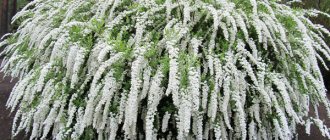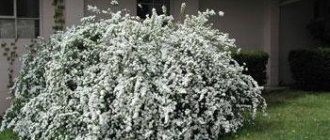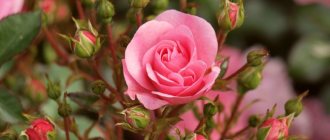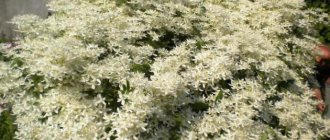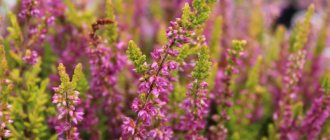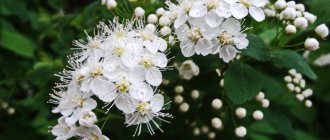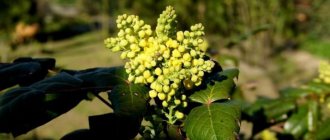Author: Elena N. https://floristics.info/ru/index.php?option=com_contact&view=contact&id=19 Category: Garden plants Published: February 23, 2019Last edits: November 08, 2020
Spiraea Vanhouttei (lat. Spiraea x vanhouttei) is a fast-growing ornamental shrub of the Rosaceae family, a deciduous hybrid between three-lobed spirea and Cantonese spirea. Spiraea Vangutta has been cultivated since 1868.
Planting and caring for spirea Vangutta
- Flowering: several weeks from mid-June or early July, re-blooming possible in August.
- Planting: in the fall, during leaf fall, although planting is possible in the spring, before the sap begins to flow.
- Lighting: bright light or light partial shade.
- Soil: any, including too wet and poor, but dry sandy soils are most suitable.
- Watering: during dry seasons, the soil should be wetted to a depth of 50 cm; the rest of the time, watering should be moderate and not too frequent.
- Fertilizing: in spring, complex mineral fertilizer for ornamental plants is applied to the tree trunk circle. If necessary, it can be added before the onset of cold weather.
- Pruning: sanitary and formative after flowering.
- Reproduction: by cuttings, layering and dividing the bush, less often by seeds.
- Pests: aphids, bud gall midges and meadowsweet blue sawflies.
- Diseases: practically not affected.
Read more about growing spirea Vangutta below
Diseases and pests
Spiraea Wangutta is resistant to many diseases and is rarely attacked by insect pests. But with high air humidity, the following may appear on it: aphids, spider mites, meadowsweet sawflies and bud gall midges.
At the first signs, treatment should be started immediately. It consists of removing damaged areas and spraying the plant with insecticides. To prevent diseases, it is necessary to weed and loosen the soil in a timely manner, as well as monitor regular watering.
Botanical description
The height of the Vangutta spirea is about 2 m, and approximately the same is the diameter of its cascading spreading crown. The branches of the plant arch downwards. Serrated along the edges, three-to-five-lobed obovate leaves of Spiraea Wangutta, up to 3.5 cm long, are dark green on the upper side, and dull-gray underneath. White flowers are collected in numerous hemispherical inflorescences covering the entire length of the shoots. Flowering begins in mid-June or early July and lasts several weeks. In July or August, spirea Wangutta may re-bloom. The fruits ripen in mid-autumn.
Planting spirea Vangutta in open ground
When to plant
For this plant, autumn planting is preferable, which is carried out from early to mid-October, but if you did not have time to plant spirea within the specified time frame, do it in the spring before sap flow begins. Spiraea Wangutta seedlings with an open root system tolerate transplantation more painfully than those in containers. By the way, seedlings with closed roots can be planted throughout the growing season.
How to grow spirea in the garden - planting and care
The spirea Wangutta shrub is unpretentious, frost-resistant, and relatively shade-tolerant, although it prefers well-lit areas. Spiraea Vangutta is insensitive to air pollution and tolerates both smoke and smog.
- Cherries: growing in the garden, types and varieties
How to plant
Spiraea grows best in dry sandy soil, but can also grow well in other soils, including poor or too wet ones.
Before planting, seedlings are placed in water for at least three hours, then damaged, dry or rotten roots are removed, and healthy ones are slightly shortened, as are shoots that are too thin or long. The pit for spirea at a depth of 40-50 cm should be a quarter larger in volume than the root system of the plant. A drainage layer of broken brick (crushed stone) and sand about 15 cm thick is laid at the bottom of the planting pit, and the top, fertile layer of soil removed from the pit is mixed with compost and sand. The seedling is placed in a hole so that the root collar is level with the surface of the site, and the remaining space is filled with soil mixture. After planting, the soil in the tree trunk circle is compacted and watered abundantly with non-cold water, and as soon as it is absorbed, the surface around the seedling is mulched with a layer of peat 7 cm thick.
When and how to harvest cuttings?
Spiraea is an ornamental shrub, represented by many unpretentious varieties of different heights and shades from white to deep red. The perennial successfully reproduces by both seed and vegetative methods. The advantage of the latter method is the preservation of all varietal characteristics of the mother plant. Any spirea hybrid can be propagated by cuttings, while seed propagation is used only for species spirea. Reproduction can be carried out throughout the growing season until autumn.
Preparation of blanks
When propagating spirea in the spring, it is better to wait until the active growth of green mass stops. At this time of year, it is recommended to take last year's woody brown shoots. If the species is summer-blooming, you will have to wait until early or mid-June.
The highest percentage of rooting is observed in branches taken in the summer after flowering. Take green shoots of the current year.
It is better to collect blanks in cloudy or rainy weather. Twigs are taken only from a healthy bush. They should grow straight up, so the new bush will take on the correct crown shape. If the mother plant is damaged by a pest, it is treated with special preparations until complete recovery. After treatment, at least three days must pass before collection. Simultaneously with spirea, you can organize the propagation of hydrangea by cuttings, as well as forsythia and weigela.
Last year's cuttings begin to root in September. In the fall, this must be done before October, so they will have time to take root before the onset of winter. The advantage of autumn propagation is the minimum care for seedlings in winter. At home, in spring and summer, cuttings require frequent watering and spraying; in winter, they have enough snow on the site.
Caring for Spirea Vangutta
Planting and caring for spirea Vangutta is simple and not labor-intensive. In dry weather and after pruning, water the plant so as to wet the soil in the circle around the trunk to a depth of about half a meter. The rest of the time, spirea needs moderate and not too abundant watering, after which the soil is loosened and weeds are removed around the plant.
Pruning the Vangutta spirea after flowering not only shapes the crown of the bush, but also stimulates the formation of new shoots and the formation of flower buds, as a result of which the spirea will bloom more luxuriantly than before. If you notice that the flowering of adult spirea has become scarce, immediately after dropping the leaves, carry out a radical rejuvenating pruning of the plant.
For normal development and abundant flowering, Spiraea Vangutta requires only one fertilizing with complex fertilizers for ornamental plants, which is applied in the spring, but some gardeners believe that the same fertilizing should be applied to the soil before the onset of cold weather.
Despite the high resistance of Spiraea Vangutta to diseases and pests, sometimes the plant can be occupied by aphids, bud gall midges and meadowsweet blue sawflies. As soon as you find pests, immediately remove all insect-affected leaves from the bush and burn them, and treat the plant with an insecticide-acaricide.
- Diascia: growing from seeds in the garden and at home
Preparing for winter
In southern and middle latitudes, the bush does not need to be covered for wintering, just cut it off and mulch the tree trunk circle. In the Urals and Siberia, additional protection will be required, even for frost-resistant varieties. In order not to weaken the spirea, before wintering it is necessary to cut off its shoots by a third. The tree trunk circle needs to be hilled up and covered with a thick layer of dry leaves, straw and peat. Young bushes should be covered with light, breathable protective material.
Note! You cannot use film for covering, otherwise the bush will begin to rot on clear days due to the greenhouse effect.
Reproduction
Since the germination rate of Vangutta spirea seeds is only 5%, the plant is propagated by cuttings, layering or dividing the bush.
Spiraea is cut about two weeks after flowering. Choose healthy and strong semi-lignified shoots for cuttings. They are rooted in a box with a substrate made of equal parts of peat and river sand. It is best to place the box with cuttings in a greenhouse, thereby ensuring a high level of substrate and air humidity. A year later, cuttings with a well-developed root system are planted in separate containers for growing.
The easiest way to propagate spirea is by rooting cuttings. In the spring, a low-growing, semi-lignified branch is bent to the ground, placed in a pre-made groove, leaving the tip of the shoot on the surface, the branch is fixed with a metal pin, after which the groove is filled with fertile soil. The cuttings are watered throughout the season and covered with dry leaves for the winter. In the spring, the rooted branch is separated from the bush and transplanted to a permanent place.
Growing Japanese spirea in the garden - planting and care
Dividing the bush can be done when transplanting spirea. The bush is dug up and carefully divided into parts, each of which should have strong roots and developed shoots. The sections are treated with crushed coal, after which the sections are planted in pre-prepared pits.
How to grow Spiraea Wangutta
This shrub is unpretentious; create only the necessary conditions. Little further participation will be required.
Soil preparation
The acidity of the soil should be “evened out”; it should be sufficiently rich in organic elements. Lime and wood ash are added to acidic soils, and soil that is too oily is “diluted” with sand or peat.
The main requirement for soil is looseness and drainage. Artificial water permeability is created by pouring gravel, broken bricks and sand into the planting hole.
Planting process and scheme
It is preferable to purchase seedlings from nursery sellers, although you can propagate adult bushes yourself. I'll talk about this below.
I plant almost all the bushes in the fall, in October-November. I planted the spirea at the same time and it is taking root well. If you are going to plant in the spring, do it early, before the sap begins to flow.
· Dig a hole with a depth and coverage of 0.5 meters;
· Place drainage at the bottom no more than 20 centimeters thick;
· Fill the soil (sand, turf soil and peat) and plant the seedling;
· Sprinkle the root system on top, compact the soil, water and mulch with humus.
The distance between spirea bushes is selected based on the type of planting. If a hedge is planned, then the scheme is as follows: 1 meter or 1.5 meters.
We are looking after
You need to water the bushes once every two weeks; for this you will need two buckets of water.
In dry times, we water as indicated above, but in cool, rainy weather, you don’t need to do anything at all. The next condition is to remove weeds from the tree trunk and loosen the soil after moistening.
The plant should be pruned for sanitary purposes and to rejuvenate the bush. In spring, broken and dried branches are removed. And after the spirea has bloomed, the bare stems are cut off. You can also remove branches on which the flowers have become smaller. We perform rejuvenation once every 3-5 years.
Meadowsweet needs to be fed at least once a year. When it blooms, I add superphosphate, you can buy it in the store and follow the directions on the package. Organics in the spring won't hurt either.
Only one-year-old seedlings may need shelter for the winter, but a well-established plant can survive even severe frosts.
Reproduction
Spiraea is propagated by seeds, layering, cuttings and dividing the bush.
The layer is bent to the ground, slightly incised and pinned with a bracket. Sprinkle it with soil and water it. This method is used in the spring, and the roots will appear by autumn. During this time, water the pinned branch.
Before wintering, you can cut the seedling from the mother bush (you can cover it with dry leaves or spruce branches), and in the spring you can transplant it to a permanent place. In one season, several such layerings can be “obtained” from an adult plant.
The next method is cuttings. Vangutta also reproduces well in this way. After flowering, a healthy young shoot is taken for cutting.
You can take several cuttings from one branch, each with up to 5-6 leaves. For rooting, we place the shoots in a greenhouse or room. In a container with substrate or in a garden bed. In the spring we plant them in the right places.
Dividing the bush. Like the two previous methods, this one is also easy to implement. After flowering, dig up the plant and divide its root system into parts. Each of them should have strong roots and 3-6 shoots. We quickly plant the prepared seedlings in the holes, following the planting procedure described above.
Varieties
Spiraea Vangutta has several decorative forms:
- Snow White - white spirea Vangutta;
- Pink Ice - young leaves of this variety are decorated with white and pink spots, and the apical inflorescences are cream-colored;
- Renaissance - spirea, characterized by high resistance to disease;
- Spiraea Wangutta Gold Fontaine is a new plant variety of Polish selection. This is a spreading, slowly growing shrub up to 120 cm high with a crown diameter of about one and a half meters. The white flowers of plants of this variety are collected in corymbose inflorescences.
Benefits of shrubs
In addition to aesthetic pleasure, the peculiar shrub has useful properties:
- honey production. During the flowering period, the shrub is a good honey plant and has a bright sweetish aroma that attracts bees. Placing hives in areas with Wangutta spirea plantings is very effective;
- decorativeness. Spiraea Vangutta is good for cutting, interesting when used in bouquets and flower arrangements;
- environmental friendliness. Thanks to its high phytoncidal activity, the shrub contributes to a healthier environment and has a beneficial effect on humans.
The undemanding spirea Vangutta is very responsive to care. The wonderful aroma and unique beauty are her gratitude.
Author: Ivanov Denis
Spiraea Vangutta in landscape design
Garden designers are attracted by the high decorative qualities of the plant, its spherical crown and abundant flowering. Spiraea Vangutta is used for single and group plantings, complex compositions, and also as borders and hedges. The Vangutta spirea bush looks impressive on a green lawn, near fountains and pools. It reliably decorates unsightly outbuildings and dilapidated walls of houses. This type of spirea goes well with other plants, for example, spruce, fir, pine or maple.
Interesting things about spirea
- The genus Spiraea received its name from an ancient Greek word, which has a number of meanings: “spiral”, “turn”, “twist”, “bend”, “convolution”. Indeed, the branches of plants belonging to this genus bend beautifully, and the leaves on the stems, as a rule, are arranged in a spiral, alternating order.
- People also have another name for spirea - meadowsweet. However, it is incorrect to call spirea that way. The genus Meadowsweet, or Meadowsweet (botanical name – Filipéndula) includes exclusively herbaceous plants. And all types of spirea are shrubs.
- In Spiraea Wangutta, like all spirea of the early flowering group, flower buds are formed on last year's shoots. In order for the plant to delight you with abundant flowering every spring, it should be pruned immediately after flowering. Only in this case will the bush have time to develop new flower buds by spring.
Author: Tatyana Dudina
